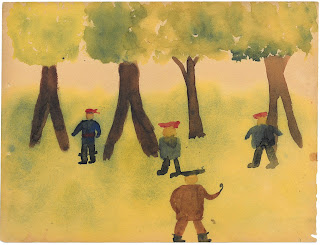While selecting materials for the Spanish class, we came across many fascinating items, including a
 pocket atlas that was printed in Madrid in 1711. The charming little volume is filled with fold-out illustrations and maps, most of which have been hand-colored with enthusiasm, if not with care. The map of Spain colorfully divides the country into clear regions, and there is a delightful map of the heavens that shows all of the creatures of the zodiac filling the sky. The engraving of the entire world includes a representation of California as an island and some random mountains above it, a signal that the reader's guess is as good as the engraver's or author's as to what awaits future explorers to the region. One of the high school students was struck by the fact that these images of the world would have been taken as fact for Spanish people of the 1700s, despite their many inaccuracies. For us, helping to provide these sorts of intellectual discoveries is even more exciting than finding a lost treasure among our stacks.
pocket atlas that was printed in Madrid in 1711. The charming little volume is filled with fold-out illustrations and maps, most of which have been hand-colored with enthusiasm, if not with care. The map of Spain colorfully divides the country into clear regions, and there is a delightful map of the heavens that shows all of the creatures of the zodiac filling the sky. The engraving of the entire world includes a representation of California as an island and some random mountains above it, a signal that the reader's guess is as good as the engraver's or author's as to what awaits future explorers to the region. One of the high school students was struck by the fact that these images of the world would have been taken as fact for Spanish people of the 1700s, despite their many inaccuracies. For us, helping to provide these sorts of intellectual discoveries is even more exciting than finding a lost treasure among our stacks.To explore Francisco de Afferden's Atlas Abreviando, come to Rauner and ask for Bryant G1015 .A3 1711.





